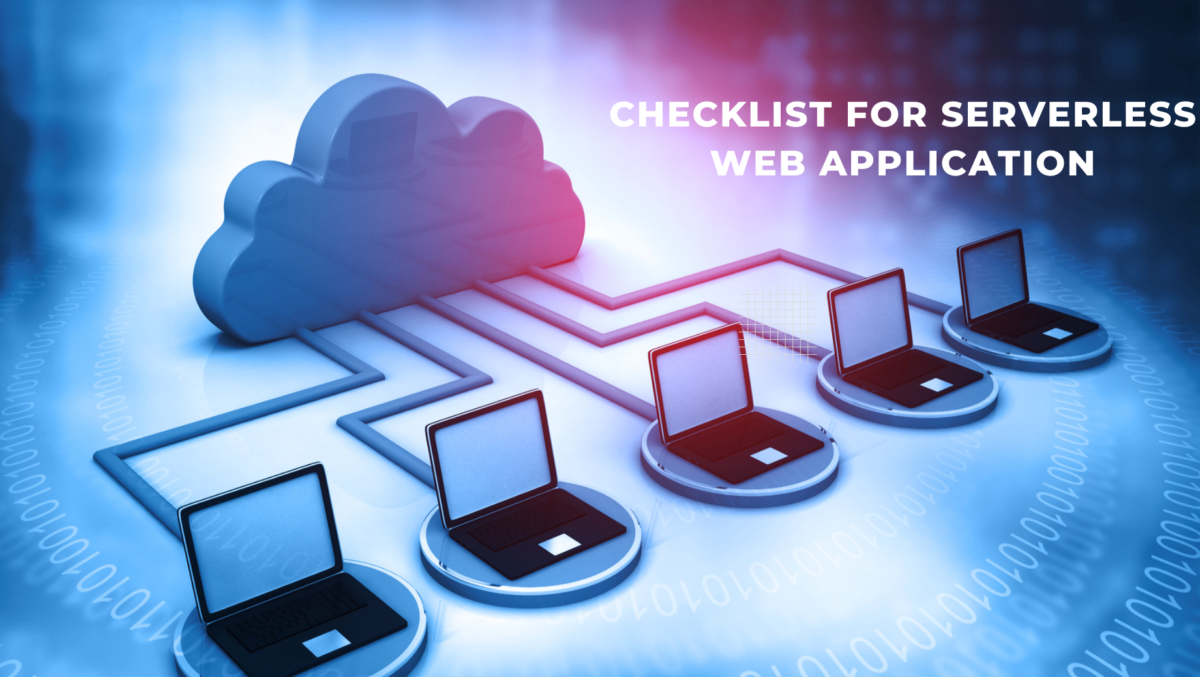10 Step Checklist For Developing Serverless Web Applications

Serverless computing has revolutionized Web Application Development in recent years. It allows developers to write code without worrying about the underlying infrastructure, particularly the servers that run the code. Instead, the cloud provider manages the application’s infrastructure, scaling, and availability. This has led to increased reliability, scalability, and cost efficiency. However, building a serverless web application requires expertise and following best practices to deliver a high-performance, scalable, secure, and cost-effective solution. This article provides a step-by-step serverless web application checklist for developing serverless web applications, including identifying appropriate service providers, defining requirements, designing architecture, developing functions and APIs, testing, deploying, optimizing, and monitoring performance.
Checklist For Serverless Web Application Development
Step 1: Identify The Appropriate Serverless Service Provider
Number 1 on the serverless web application checklist is choosing the right serverless service provider is crucial for developing a serverless web application. The most popular cloud providers for serverless computing are Amazon Web Services (AWS), Microsoft Azure, and Google Cloud Platform. Each provider has strengths, weaknesses, costs, features, and limitations. Therefore, it’s essential to analyze each provider’s services and determine which best fits your application requirements, availability, reliability, and scalability needs.
For instance, AWS Lambda is an event-driven computing service that scales automatically based on demand. AWS offers many other serverless services, such as API Gateway, DynamoDB, and S3 storage. On the other hand, Azure Functions and Google Cloud Functions offer similar services as AWS Lambda but with different pricing structures, features, and language support. Azure Functions, for instance, integrate well with other Azure services and tools like Visual Studio. At the same time, Google Cloud functions can run on multiple clouds, including AWS, Kubernetes, and Microsoft Azure.
Step 2: Define Application Requirements
Before developing a serverless web application, it’s important to clearly understand its requirements. Identify the target audience, functionality, scalability needs, tools, performance, and security needs. Serverless applications are best suited for small and medium applications that require on-demand scalability, cost efficiency, and easy deployment. Some typical applications that can utilize serverless architecture are chatbots, web and Mobile Applications Development, IoT, and media processing.
It’s best to document your application requirements, including diagrams, wireframes, user stories, use cases, and data flow diagrams, among others. This helps you understand the application’s needs, develop a clear deployment roadmap, and enable effective collaboration with other team members.
Step 3: Identify Functions-As-A-Service (Faas) Services
Another step on serverless web application checklist is Functions-as-a-Service (FaaS) is a cloud computing model that enables developers to execute code in response to events without the need to manage infrastructure. FaaS provides a runtime environment for running functions or microservices on the cloud platform. This model enables developers to focus on writing code rather than worrying about servers.
In a serverless application, the application code is broken down into individual functions that are executed separately in response to events such as user requests, changes to data, or API requests, among others. Some popular FaaS services include AWS Lambda, Azure Functions, Google Cloud Functions, and IBM Cloud Functions, among others.
When choosing FaaS services, consider relevant factors such as language support, pricing structure, scalability, availability, performance, and vendor lock-in. Each platform provides varying levels of support for programming languages, with some offering more than 10 languages. Supported languages include Python, Node.js, Java, Ruby, C#, Go, and PHP.
Step 4: Choose A Database Provider
Choosing the right database provider is crucial to ensure your serverless application’s performance, scalability, and reliability. There are two main types of databases in serverless architecture: NoSQL and SQL. The choice between the two depends on the application’s needs, data type, storage capacity, and complexity.
NoSQL databases are highly scalable and can store large amounts of structured and unstructured data. They are highly suited for serverless architectures, where you must scale up and down depending on traffic levels. Some popular NoSQL databases include MongoDB, Cassandra, DynamoDB, and Google Cloud Bigtable.
SQL databases, on the other hand, provide relational data stores and are best suited for transactional and complex applications. They are excellent for handling multi-table data structures that require many joins or the ‘join process’ of data. Some database providers that offer serverless SQL services include Google Cloud SQL, Amazon Aurora Serverless, and Microsoft Azure SQL Database.
It’s crucial to select a database provider that offers good integration with your FaaS service and provides robust documentation and support.
Step 5: Design Serverless Architecture
Designing a serverless architecture is a crucial step of a serverless web application checklist toward developing a serverless web application. A well-designed architecture ensures the application is reliable, scalable, and cost-efficient while minimizing the risk of vendor lock-in. This involves breaking down the application code into individual functions that can be executed independently.
The first step in designing serverless architecture is to identify the application’s entry points, which could be an API gateway or a client-side application. Each entry point maps to a series of event triggers that execute specific functions or workflows. The event triggers can be HTTP requests, database triggers, file system events, or message queue events.
It’s also important to consider the data flow between functions and between the serverless architecture and external services. This ensures that the application data flows seamlessly, matching the application’s requirements. The architecture should also separate computation resources based on application workload and scalability requirements.
Serverless architecture should also integrate with standard security protocols like OAuth2, OpenID, and SSL for secure data transmission. It’s also crucial to incorporate proper logging and monitoring of the serverless architecture for troubleshooting and error analysis.
Step 6: Develop Functions And
Developing functions and APIs is a critical step in serverless web application development. Functions are the building blocks of serverless applications since they are the code that executes in response to an event trigger. APIs expose the functions to external clients or applications.
When developing serverless functions, following the best practices for writing scalable, reliable, and maintainable code is vital. Functions should be small, stateless, and independently deployable. They should also be designed to handle error conditions and timeouts gracefully.
APIs, on the other hand, should be well-documented, secure, and compliant with relevant standards. The API documentation should include the API endpoint, methods, parameters, and response status codes.
It’s also important to leverage proper API gateway management to enable effective routing and efficiency of client requests.
Step 7: Define The Testing Strategy
Proper testing of your serverless web application ensures its reliability, scalability, and security. Testing should be done throughout the development process, including unit, integration, and end-to-end testing.
Testing should cover all the functions, APIs, and external service integrations in the serverless architecture. It should also include testing for security vulnerabilities, load testing, and compatibility testing with various clients and devices.
Testing should be automated where possible to ensure consistency and speed up execution. Integration testing tools like Serverless Framework, SAM CLI, and Concourse enable developers to test serverless applications locally and in the cloud.
Step 8: Deploy Serverless Application
Once you’ve developed a robust serverless web application, you need to deploy it to your chosen cloud provider as an next step of the serverless web application checklist. Serverless applications are deployed as small packages that contain code and configuration metadata.
It’s essential to compress or ‘zip’ the code package to minimize its size and make it easier to upload to the cloud. Cloud providers usually provide deployment tools such as the AWS CloudFormation and Serverless Application Model (SAM) for deploying serverless applications.
It’s also important to test your deployed application on the cloud platform to ensure it’s running as expected.
Step 9: Optimize Serverless Application
Optimizing your serverless application involves tuning its performance, efficiency, and cost-effectiveness. This involves analyzing the application’s logs, usage patterns, and resource utilization, among other factors.
Optimization may involve fine-tuning parameters like memory allocation, function timeouts, and cold start time. It’s also important to leverage auto-scaling and only deploy functions essential to the application’s needs.
Optimizations should also involve the following:
- Using cost-saving tools, such as scheduling functions based on demand.
- Minimizing data storage needs.
- Leveraging reserved instances for cost savings.
Step 10: Monitor Application Performance
Monitoring your serverless web application is crucial to ensure it’s performing optimally and meeting the application’s requirements. Cloud providers offer performance monitoring tools that track serverless functions, API calls, and external service integrations.
Monitoring should track metrics like latency, error rates, and average response time to detect and troubleshoot issues promptly. You can also integrate third-party services like Datadog, New Relic, and AWS CloudWatch for enhanced monitoring and analysis.
Best Practices When Developing Serverless Web Applications
When developing a serverless web application, it’s essential to adhere to best practices to ensure reliability, scalability, security, and cost efficiency. Here, we highlight some of the best practices by top web development company when developing serverless web applications:
1. Security
Security is paramount when developing serverless web applications. Due to the distributed nature of serverless architectures, security could be challenging. Best practice guidelines include:
– Implementing role-based authentication and least-privilege principles to minimize security vulnerabilities.
– Implementing SSL/TLS to ensure data encryption during transmission.
– Restricting and monitoring access to APIs and functions.
– Regular assessment of the application for vulnerabilities and fixing of identified weaknesses.
2. Performance
Performance is a critical consideration in serverless web application development. Performance affects user experience and application responsiveness and can also affect cost. Best practices for optimal performance include:
– Using a performance-oriented language like Node.js due to its efficiency and scalability.
– Using caching strategies like content delivery network (CDN), server-side caching, and client-side caching to minimize response time.
– Avoiding excessive use of cross-function dependencies and I/O operations.
– Minimizing data transmission and payload size to optimize scalability.
3. Monitoring
Monitoring is critical in identifying and resolving issues that may arise during the application’s lifecycle. Effective monitoring involves:
– Leveraging built-in application performance monitoring (APM) services offered by cloud providers.
– Regularly analyzing logs to identify performance issues and errors.
– Using log analysis tools like CloudWatch, ELK Stack, or Grafana to aggregate and analyze logs and metrics.
– Customizing alerting rules to notify when specific performance metrics fall below a predetermined threshold.
4. Debugging
Debugging serverless web applications requires different strategies compared to traditional web applications. Best practices for efficient debugging include:
– Instrumenting functions and APIs to enable tracing of specific code paths.
– Using remote debugging tools like Visual Studio to debug running functions and APIs remotely.
– Capturing full stack traces to isolate the source of errors.
– Implementing automated testing and deployment strategies to flag errors early in the development lifecycle.
5. Versioning
Versioning is essential in maintaining a stable and predictable development process. Versioning allows developers to track changes made to the application over time, identify issues and revert to previous versions as needed. Best practices for versioning include:
– Using source control management (SCM) tools like Git or BitBucket for source code versioning.
– Applying semantic versioning to module and package dependencies.
– Implementing continuous integration and deployment strategies for automated version control.
6. Regions, Zones, And Resiliency
Deploying serverless web applications in multiple regions and zones, also known as fault tolerance, enables high availability and resiliency. Best practices for deploying in multiple regions include:
– Identifying regions that align with the application’s requirements.
– Implementing automatic failover strategies to ensure minimal disruptions in an outage.
– Making use of replicated data to minimize downtime and increase disaster resilience.
– Performing regular testing on the deployed application to ensure high availability and resiliency.
7. Functionality
When developing serverless applications, focusing on functionality, user experience, and functionality is essential. Best practices for ensuring optimal functionality include:
– Writing code using the best practices for scalability, modularity, and maintainability.
– Ensuring that the functions and APIs are stateless, easily deployable, and scalable.
– Leveraging automation tools for testing, deployment, and monitoring to minimize the human error factor.
8. Cost Optimization
Serverless computing offers cost-efficiency since you only pay for what you use. However, costs can quickly spiral out of control if not managed well. Best practices for cost optimization include:
– Analyzing the application’s usage patterns regularly and optimizing functions based on demand.
– Applying strategies like cold start mitigation and scheduled scaling to reduce costs.
– Using reserved and spot instances to reduce the cost of running functions.
– Ensuring the application is optimized to reduce network, storage, and processing costs.
9. Team Collaboration
Collaborative development of serverless web applications ensures a smooth development process. Best practices for facilitating team collaboration include:
– Establishing collaboration channels like documentation, code reviews, and issue management software.
– Encouraging contribution and engagement from developers, QA engineers, and stakeholders.
– Having a frequent, open dialogue between team members to ensure alignment and understanding of objectives.
– Assigning roles and responsibilities to the appropriate individuals based on their skill set and areas of expertise.
10. Architecture Diagrams
Serverless web applications involve a complex architecture that could be challenging to understand without appropriate documentation. Best practices for documenting the application’s architecture include:
– Creating an architecture diagram detailing the application’s components and their interactions.
– Including data flow diagrams and process flow diagrams to help understand the application’s behavior.
– Documenting critical points of failure and how they can be mitigated.
– Updating documentation regularly to align with changes to the application’s architecture.
Conclusion
Building a serverless web application requires a step-by-step checklist that includes identifying appropriate service providers, defining requirements, designing serverless architecture, developing functions and APIs, testing, deploying, optimizing, and monitoring performance. By following these best practices, you can build a reliable, scalable, secure, and cost-effective serverless application that meets your application’s needs.
Thank you for reading this comprehensive guide on serverless web application development. If you’re looking to develop a serverless web application, our team at Ateam – the top web development company has the expertise and experience to help you build a robust, scalable, and cost-efficient serverless application that meets your business needs. Our web development services are recognized by the top companies. Contact us today to schedule a consultation and learn about our web development services and how we can help you take advantage of the benefits of serverless computing.

